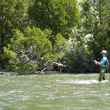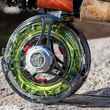I first fished a Redington fly rod about a dozen years ago—they were a premium partner with Trout Unlimited (and still are, through their parent company, Farbank), and I was able to purchase a rod-and-reel combo for an affordable price in advance of my first-ever trip to Prince of Wales Island in southeast Alaska.
I bought a 9-foot 7-weight combo and it lasted about two days before one of the ferrules split while fighting a pink salmon. Back then, I was of the mind that you get what you pay for. And I didn’t pay much. I did, though, file the incident away, and every time I picked up a Redington fly rod, I recalled the day one failed me.
But things change. A few years ago, I reviewed and then purchased the Redington Butterstick. It’s my favorite fly rod in my not-so-small collection, largely because I prefer to fish small water for wild and native trout. The Butterstick is a throwback 2-weight glass rod that fishes exactly how it’s supposed to—soft, subtle and slow. I absolutely adore it.
The Butterstick changed my perception of Redington. In recent years, I’ve had a few more Redington rods put in my hands, and I’m liking what I see. I am convinced that this is a brand that’s learning from its past as a “discount” rod maker and starting to become an operation where value and quality are coming together at a nice, little sweet spot in the fly rod market.
Enter the Hydrogen.
At first glance, the finicky angler might bristle at the bare space between the butt and the reel seat, or the simple and not-so-fancy hardware. It’s … Spartan. But, that’s not a bad thing. Read on.
What works
I had the opportunity to fish the Hyrdogen this past summer on a bucket-list trip to the Arctic. I fished the model’s 9-foot 5-weight, and, at the urging of Redington’s brand manager, Josh Prestin, the 9-foot 3-weight. First, the 5-weight.
The Hydrogen is a medium-fast rod that’s suitable for casting dry flies, high-sticking for nymphs and swinging smaller streamers. Redington did a nice job—and in an innovative way—of reducing the rod’s overall weight (no reel seat insert, single-foot guides, etc.), making it a great all-around rod for general fly fishing. I found the rod easy to cast, balanced well and equipped with enough backbone to tackle everything from 20-inch cutthroats in southern British Columbia to fat, beefy grayling north of the Brooks Range and eventually ocean-going Dolly Varden on Prince of Wales where Redington more than made up for that broken rod all those years ago.
I liked the 5-weight for its all-purpose ability. It’s a solid rod that can be used in multiple situations. After fishing the 5-weight on The Elk and Bull rivers in B.C., it became my “go-to” big-water rod throughout the trip, and I never felt undergunned.
The 3-weight, though, really impressed me. Light and tight, it has the same general profile as its big brother, but it’s a bit more subtle. And, I’ll be honest, I was skeptical. Most light-weight rods I fish are shorter and more supple than the Hydrogen, but I quickly fell for the rod’s 9-foot profile—on Montana’s upper Bitterroot, some unsettled weather put the river’s dry-fly loving cutthroats down, and I didn’t hesitate to go deep with a weighted nymph to chase them. The length made it possible to do so, and still fish a relatively light rod.
For dries, the 3-weight’s 2.3 ounces were ideal for all-day fishing on rivers like B.C.’s Buckinghorse for grayling or for wild rainbows introduced into a small creek outside of Whitehorse in the Yukon. Paired with Redington’s truly simple Zero fly reel, this combo quickly became my first choice when I was fishing for rising trout and grayling on hard-to-reach water. The length made longer casts more achievable and it was easier to keep big fish out of wood and debris after they were hooked. For smaller water, it’s an ideal implement.
What doesn’t
As I said, the Hydrogen is Spartan. It’s not a rod for “specialty” fly fishing. It’s likely not fast enough for most die-hard streamer swingers, nor is it slow enough for anglers who must make that delicate cast with a 10-foot, 7x leader over spring-creek trout. It’s a generalist’s fly rod, and it’s good for everyday use—and I did use it almost every day for about 10 weeks.
Also, if you’re into aesthetics, and that rosewood reel seat insert is important to you, the Hyrdogen won’t appeal to you. I was skeptical, to be honest, but after a time, I began to appreciate the “everything you need, nothing you don’t” approach Redington took when it constructed the Hyrdogen. I never noticed the lack of a reel-seat insert, and the rod and reel worked perfectly well together without it.
Final word
As I noted, I’ve turned the corner on Redington. The brand has shown the willingness to experiment (remember the red-handled Vapen?) and take some chances, while still working hard to offer the value most of us seek when we shop for gear. At just under $300, the Hydrogen isn’t “cheap,” but I can attest to its value.
And I'm not the only one. In a summer 2016 gear roundup, Todd Tanner wrote of the Hydrogen, "... seriously, this is one of the finest casting rods I’ve ever fished, at a price that’s $500 less than a lot of its closest competition. I was—and am—blown away by how well this rod performs."
It's easy to recommend the Hydrogen, particularly to anglers seeking an all-around rod at a reasonable price.































Comments
Paul Peters replied on Permalink
I have fished the hydrogen for a day on a trout stream in Germany. The weight made a possible to fish effortlessly all day long. The length gave me much control while mending and strike when fish were taking my fly. I am very pleased with the rod.
Pages